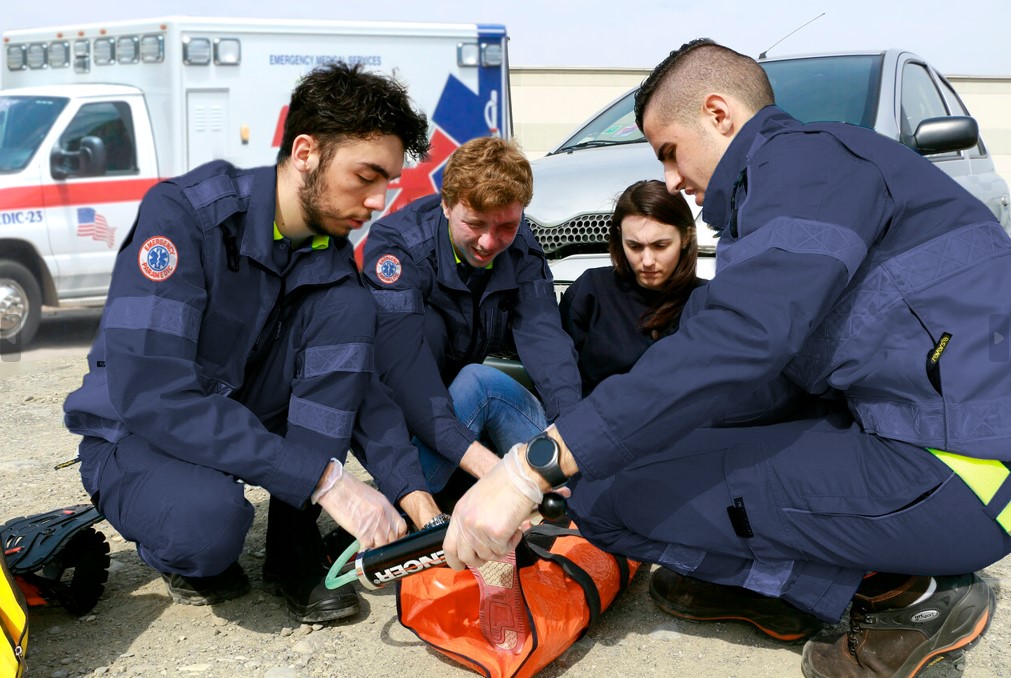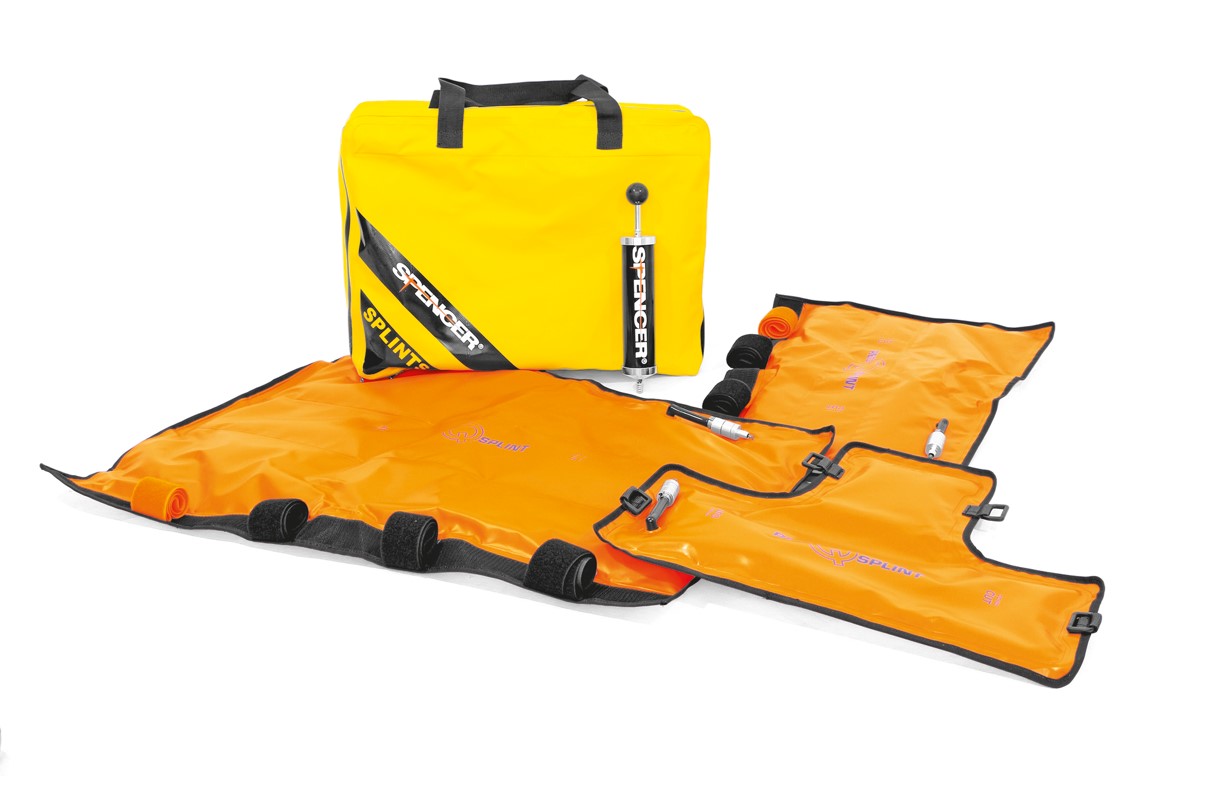
Vacuum splint: Explaining the Spencer Res-Q-Splint Kit And How To Use It
The vacuum splint is a device which looks like a vacuum mattress of reduced dimensions, it is used in emergency medicine for the immobilisation of traumatised limbs and as a temporary splint
Splints work by extracting the air from the splint itself, which then assumes the shape and rigidity required to stabilise the limb injury, be it trauma, joint dislocation, subluxation or fracture.
The splint kit you will find in your ambulance
Before explaining in detail how to use these vacuum splints, let’s see what a Res-Q-Splint Kit by Spencer contains and when the various emergency splints are used.
The bag, which is always placed in an dedicated compartment in a standard ambulance, has a pocket in which the suction pump is placed.
This is an essential aid: the pump has the specific purpose of depressing the splints by sucking the air out of them.
The Res-Q-Splint Kit bag contains three splints of different size and function
- The small splint has the primary function of protecting the wrist and hand.
- The medium splint has the primary function of providing protection to the upper limbs.
- The large splint has the primary function of providing protection to the lower limbs, and a secondary function as an emergency vacuum mattress for paediatric or neonatal patients.
Each splint is made of rubbery plastic material that can be washed and disinfected after each use.
Handling trauma patient with the Res-Q-Splint
The management of the trauma patient requires a range of skills, including scene management, choice of safe intervention procedures, risk assessment, patient assessment and treatment.
These skills are particularly relevant if the management of the trauma patient takes place in scenarios such as road accidents or rescue in maxi-emergencies (earthquakes, floods and, in winter, avalanches).
Vacuum splints are mainly used for the stabilisation and splinting of various forms of limb injuries.
Adequate levels of splinting are achieved through the correct sizing of the splint, the sculpting of the splint on the patient’s limb and the removal of excess air from the device.
![]() Splint application procedure
Splint application procedure
- First choose the splint from the Res-Q-Splint Kit suitable in form and function for the type of trauma observed on the patient: a correctly sized splint immobilises the joints above and below the site of injury.
- Lay the splint with the valve side down on a flat surface, manually distributing the beads of content evenly over the entire splint.
- Slide or position the splint under the injured area, positioning it so that at least one band is above and below the suspected lesion site.
- Support the splint and gently manipulate the beads to achieve the best possible conformal mould.
- Mould the splint cover.
- Connect the hand pump to the valve end – an audible ‘click’ will confirm correct positioning.
- Use the manual pump to evacuate air from the splint.
- Disconnect the valve and pump coupling by pressing the metal release tab on the pump connector.
- Fasten the splint straps with light tension around the splint.
- Check the patient’s distal blood circulation immediately after splint application. Recheck distal pulses and vital signs regularly throughout the duration of care.
In line with the standard guidelines for immobilisation – ‘immobilise the joint above and below the fracture and/or dislocation’ – the splint is indicated for use in:
- Knee dislocations
- Patella fractures
- fractures of the tibia and/or fibula
- Ankle and/or foot dislocation
- Ankle and/or foot fractures
- Fractures of the humerus (in combination with anatomical splints)
- Elbow dislocation
- Elbow fractures
- Fractures of the ulna and/or radius
- Wrist or hand dislocation
- Wrist or hand fractures
Femur fractures require the use of traction splints in specific cases, while NOF and spinal fractures benefit from the use of a vacuum mattress.
The use of Res-Q-Splint is recommended in cases of suspected limb injuries or fractures, with the aim of avoiding further damage during pre-hospital rescue operations.
Watch the video tutorial on Res-Q-Splint splints by Spencer
Read Also
Emergency Live Even More…Live: Download The New Free App Of Your Newspaper For IOS And Android
Emergency Equipment: The Emergency Carry Sheet / VIDEO TUTORIAL
First Aid In Road Accidents: To Take A Motorcyclist’s Helmet Off Or Not? Info For The Citizen
Spencer WOW, What’s Going To Change In Patient Transport?
Spencer Tango, The Double Spinal Board That Ease Up Immobilization
MERET Emergency Backpacks, Spencer’s Catalogue Is Enriched With Further Excellence
Emergency Transfer Sheet QMX 750 Spencer Italia, For Comfortable And Safe Transportation Of Patients
Cervical And Spinal Immobilization Techniques: An Overview
Spinal Immobilization: Treatment Or Injury?
10 Steps To Perform A Correct Spinal Immobilization Of A Trauma Patient
Spinal Column Injuries, The Value Of The Rock Pin / Rock Pin Max Spine Board
Spinal Immobilisation, One Of The Techniques The Rescuer Must Master
Electrical Injuries: How To Assess Them, What To Do
RICE Treatment For Soft Tissue Injuries
How To Carry Out Primary Survey Using The DRABC In First Aid
Heimlich Maneuver: Find Out What It Is And How To Do It
What Should Be In A Paediatric First Aid Kit
Poison Mushroom Poisoning: What To Do? How Does Poisoning Manifest Itself?
Hydrocarbon Poisoning: Symptoms, Diagnosis And Treatment
First Aid: What To Do After Swallowing Or Spilling Bleach On Your Skin
Signs And Symptoms Of Shock: How And When To Intervene
Wasp Sting And Anaphylactic Shock: What To Do Before The Ambulance Arrives?
UK / Emergency Room, Paediatric Intubation: The Procedure With A Child In Serious Condition
Endotracheal Intubation In Paediatric Patients: Devices For The Supraglottic Airways
Sedation And Analgesia: Drugs To Facilitate Intubation
Intubation: Risks, Anaesthesia, Resuscitation, Throat Pain
Spinal Shock: Causes, Symptoms, Risks, Diagnosis, Treatment, Prognosis, Death
Spinal Column Immobilisation Using A Spine Board: Objectives, Indications And Limitations Of Use
Spinal Immobilisation Of The Patient: When Should The Spine Board Be Put Aside?
Earthquake Bag, The Essential Emergency Kit In Case Of Disasters: VIDEO



